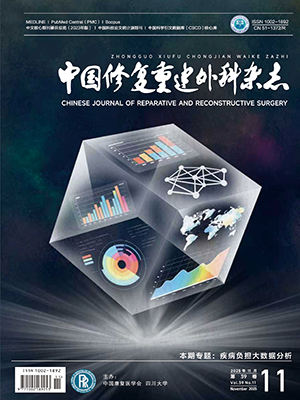Objective To investigate the influence of different transplantating times on the survival and immigration of the bone marrow mesenchymal stem cells (BMSCs) in injured spinal cord by subarachnoid administration, and to evaluate
the most optimal subarachnoid administration times for BMSCs. Methods Eight adult male rats (weighing 120 g) were
used to isolate BMSCs that were cultured, purified and labeled with Hoechst 33342 in vitro. Another 75 adult Wistar rats
(weighing 220 g) were made the spinal cord injury (SCI) models at T9,10 level according to the improved Allen’s method and were randomly divided into 5 groups (groups A, B, C, D, and E, n=15). The labeled BMSCs at 1 × 107
/mL 0.1 mL were injected into subarachnoid space of the rats via a catheters under the subarachnoid space in groups A (one time at 1 week), B ( two times at 1 and 3 weeks), C (3 times at 1, 3, and 5 weeks) and D (5 times at 1, 3, 5, 7, and 9 weeks) and 0.2 mL phosphate-buffered sal ine (PBS) was injected in group E (5 times at 1, 3, 5, 7, and 9 weeks) as blank control. The neurological functions were evaluated using the Basso-Beattie-Bresnahan (BBB) scale 1, 3, 5, 7, 9, and 12 weeks after transplantation. The migration, survival, differentiation, and histomorphological changes of BMSCs were observed by HE, immunohistochemistry, and fluorescence microscopy. Results At 3 weeks after injury, there were significant differences in the BBB scores between group E and groups A, B, C, D (P lt; 0.01), and between groups A, B and groups C, D (P lt; 0.01). At 7, 9, and 12 weeks, the BBB scores were significantly higher in groups C and D than in groups A and B (P lt; 0.01), and in group B than in group A (P lt; 0.01). There were no significant differences in the BBB scores between groups C and D (P gt; 0.05). The fluorescence microscopy showed that the transplanted BMSCs survived and grew in the injured region at 3 weeks after injury and as time went on, the transplanted cells gradually decreased in group A; in groups B, C, and D, BMSCs count reached the peak values at 5 and 7 weeks and then gradually decreased. At 12 weeks, the survival BMSCs were significantly more in groups C and D than in groups A and B (P lt; 0.01). HE staining showed that the formation of cavity was observed in each group at 3 weeks after injury and the area of cavity gradually decreased in groups A, B, C, and D. At 12 weeks, the area of cavity was the miximal in groups C and D, moderate in groups A and B, and the maximal in group E. The immunohistochemistry staining indicated that the expression of NF-200 was more intense in groups C and D than in groups A and B. The expression of NF-200-positive fibers was more intense in group C. Conclusion Multiple administration of BMSCs promotes the restoration of injured spinal cord and improves neurological functions, and three times for BMSCs transplantation is best
Citation: LI Huiying ,WEN Yimin,LUO Yali,LAN Xu,WANG Dabin,SUN Zhengang,HU Lingyun. TRANSPLANTATION OF BONE MARROW MESENCHYMAL STEM CELLS INTO SPINAL CORD INJURY : A OMPARISON OF DELIVERY DIFFERENT TIMES. Chinese Journal of Reparative and Reconstructive Surgery, 2010, 24(2): 180-184. doi: Copy
Copyright © the editorial department of Chinese Journal of Reparative and Reconstructive Surgery of West China Medical Publisher. All rights reserved




